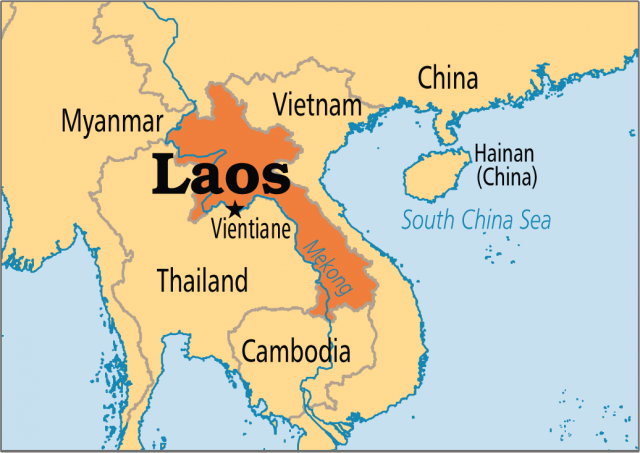Laos
Area 91,429 square mi (236,800 square km)
Population 5,921,545
Capital Vientiane
Highest Point 9,240 ft (2,817 m)
Lowest Point 230 ft (70 m)
GDP per capita $326
Primary Natural Resources timber, hydropower, gypsum.
LAOS, THE ONLY landlocked (without any ocean coastline) Southeast Asian country, is one of the poorest of the world, with 40 percent of its population living below the poverty line. Its six-century-old monarchy, which also included French occupation (1893–1953), had dual capitals in Vientiane and Luang Prabang. The monarchy ended in 1975, when the communist Pathet Lao rebel forces, backed by North Vietnam, took control of the government. Laos turned into a communist satellite of the Soviet Union and VIETNAM but maintained a more neutral position than Vietnam and CAMBODIA. After aid from the Soviet Union ceased in 1991, the UNITED STATES, JAPAN, and international agencies provided the aid, without which the country would have been in great difficulty. The post-1975 collectivization of farms and nationalization of a few industries were replaced by a return to market economy and liberal foreign investment laws. Laos remains a communist country.

Western and northern parts of Laos are mountainous; the former includes a part of the Annamite Cordillera, where there are areas that receive 80 to 120 in (203 to 305 cm) of rainfall. Vientiane, the capital receives 68 in (173 cm) annually. Being in a monsoon climatic regime, there is a great deal of uncertainty about rainfall. Only 3.47 percent of the land is arable though 80 percent of the labor force is engaged in agriculture. Rice dominates the food crops and accounts for about three-fourths of the total crops produced.
Laos is self-sufficient in rice, but it needs money to run the government and other activities. Its primary production-related industries (tin, beef, pork, cigarettes, and wood) are in their primitive stages. Upper reaches of the MEKONG RIVER on the western part of the country collect most of the drainage from the rest of the country. The Mekong is suitable for navigation only in sections because of several rapids.
POPULATION GEOGRAPHY
The population of Laos shows characteristics of a lessdeveloped country: more people in the lower age groups (42 percent are in the age group 1 to 14 years); high birth rates (37 births per 100 people); low life expectancy (54 years); high infant mortality rate (89 per 1,000 births); and a high fertility rate (4.94 children born per woman in reproductive age). Sixty percent of Laotians are Buddhist and the remaining 40 percent are animists and others.
There are three strata of people in Laos: 1) Austro-Asiatic group, consisting of 25 percent of the country's population. They were the earliest settlers but were driven into the mountains above 3000 ft (914m) by the Tai and Lao; 2) Lao Loum, who originated from South China and live in the most productive lowland river valleys, growing glutinous rice, accounting for 68 percent of the country's population. They are the most educated and are the major decision makers; 3) Lao Sung, consisting of 9 percent of the population, are the 19th-century migrants from South China, living in the northern highlands. There an an ongoing government policy of “Laoization,” in which efforts are made to acculturate the Lao Theung and Lao Sung minorities in Lao Loum cultural traits. The government encourages ethnic harmony.